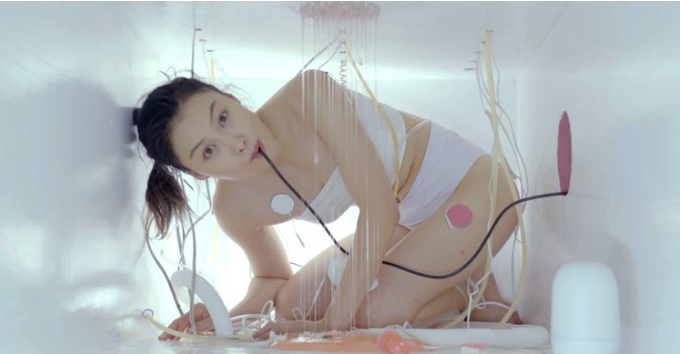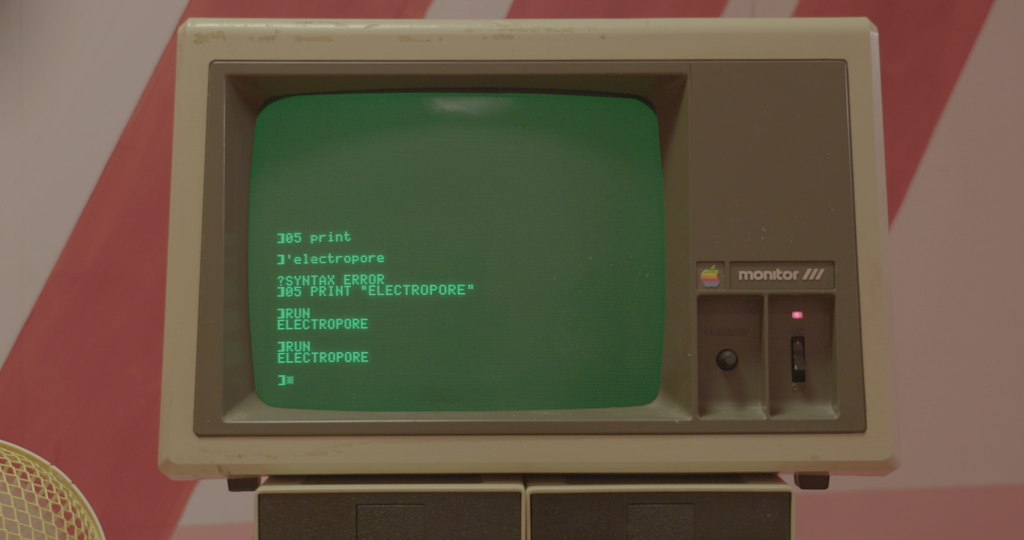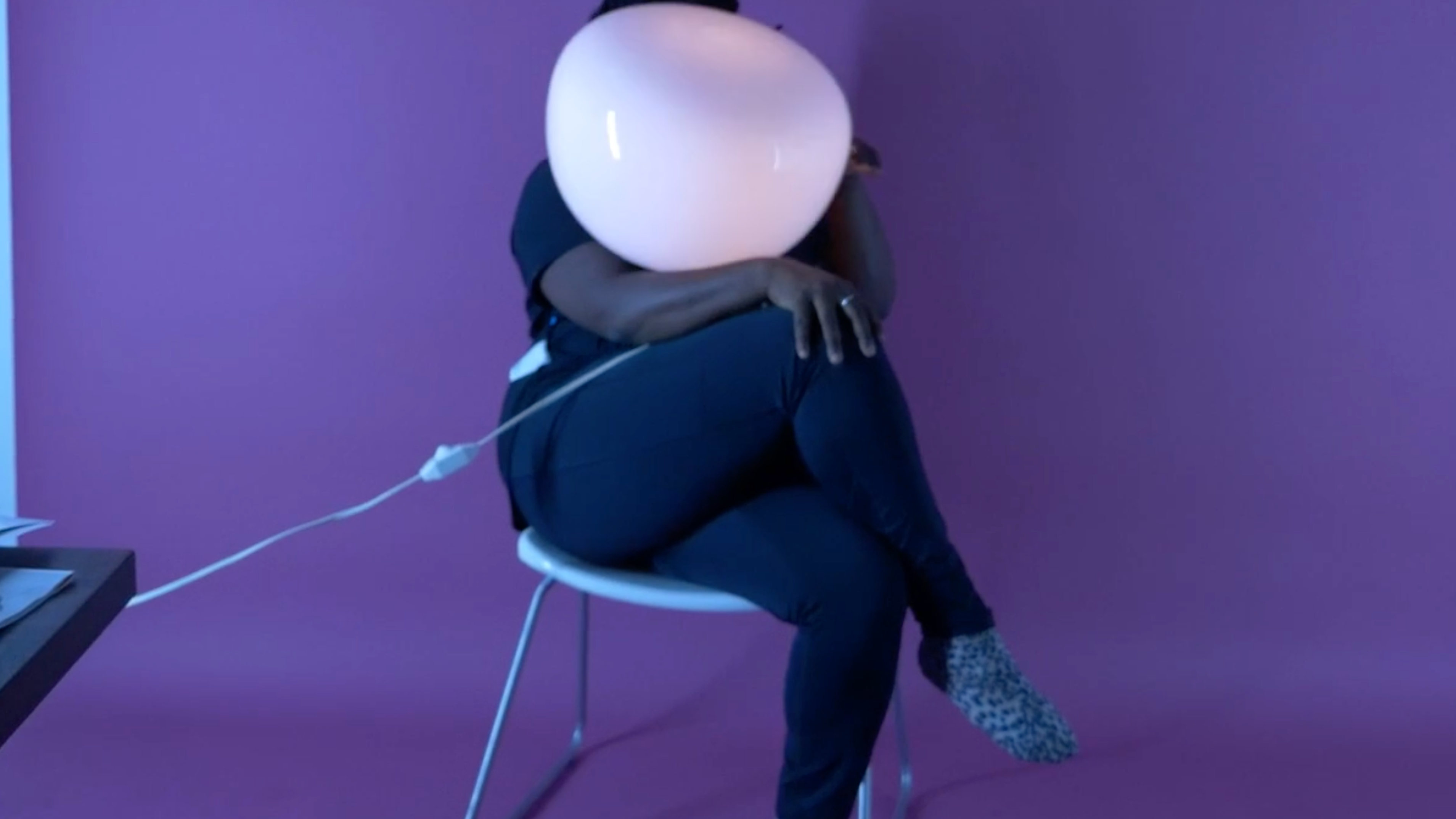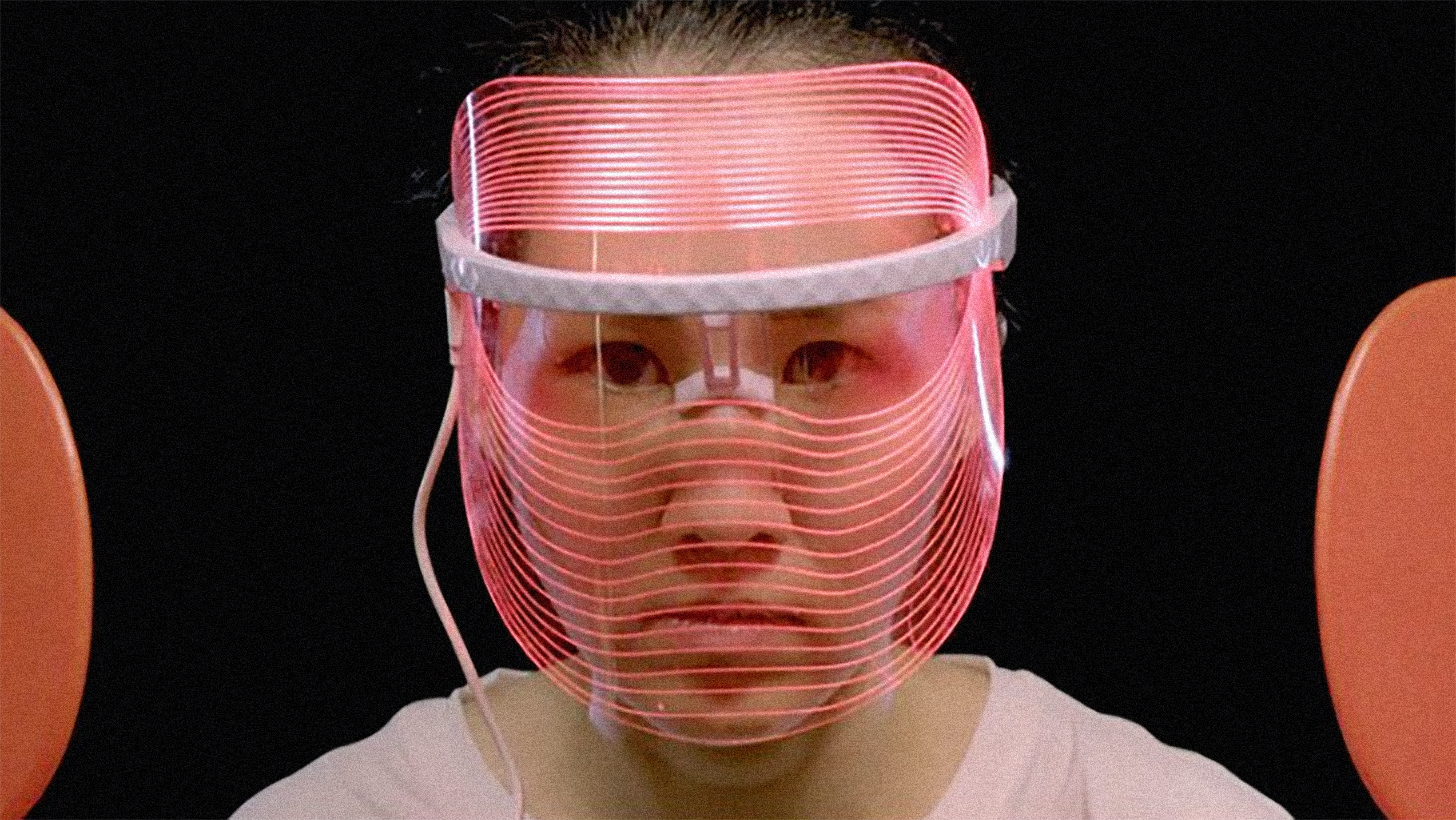
Credits:
By Jackson Bisaccia, Summer 2021 Curatorial Research Intern
January 12, 2022
Jen Liu's work-in-progress video Pink Slime Caesar Shift: Electropore (2021)—the newest chapter in her ongoing body of work Pink Slime Caesar Shift (PSCS)—was released in The Kitchen’s Video Viewing Room on September 30, 2021. This new work examines the connective tissues between a biologically manipulated future, fake news, media-encouraged hysteria, consumer capitalism, and the labor realities of commodity production in the global south. Liu’s multimedia practice utilizes thorough research into multiple fields of study, conjuring connections into audio-visual works embodying the instability of our global reality. Pink Slime Caesar Shift is a series that Liu has been developing since 2017: the project spans video, sculpture, painting, performance, and biomaterial. As the artist has stated, PSCS “builds on a speculative proposal to build a secret information network for labor activists in China through the domestic food distribution grid—by inserting covert messages into the DNA code of in-vitro beef hamburgers.”

As a research intern working with Liu in summer 2021, I had the pleasure of experiencing and participating in the development of* Electropore*. It is through that process, as well as through an in-depth interview I conducted with the artist during that time, that I witnessed Liu’s ability to survey complex histories and present realities. [1] Taking the pieces that form our past and current moments, Liu recontextualizes them to assess the now. Her work builds a speculative future positioned from a communist, feminist, BIPOC perspective. Liu champions the fundamental belief that artistic practice has the potential to be revolutionary, allowing art’s core functions and the possibilities for its audiences to expand.
The Kitchen has a profound history of uplifting artists who have similar approaches to their work. It is for this reason that Liu wanted to interact directly with The Kitchen’s archive, specifically with the work of composer, saxophonist, and activist Fred Ho, when conceptualizing this chapter of PSCS. Liu connected with one of Ho’s pieces in particular that premiered at The Kitchen in November of 2000: Warrior Sisters: The New Adventures of African and Asian Womyn Warriors. Ho conceptualized and developed this feminist action-adventure opera with librettist Ann T. Greene. The piece centers four BIPOC womyn activists and warriors: China’s Fa Mu Lan, the 1000-year-old female avenger and legend; Nana Yaa Asantewa, the Queen Mother and military general of the Ashante peoples; Sieh King King, a teenage feminist reformer of 19th century China; and Assata Shakur, of the Black Liberation Army and Black Panther Party. In the work, these four figures band together to create what the program describes as “a matriarchal guerilla army to destroy patriarchal-capitalist imperialism.” Liu drew from Ho’s work and components of Warrior Sisters as inspiration while developing her new video for The Kitchen. Formally, Liu adapts Warrior Sister’s score, electrifying the music by merging the original songs with the genre of acid house music that emerged with rave culture of the 1980s. Conceptually, Liu meditates on and incorporates Ho’s belief in the avid necessity for Afro-Asian coalition, which is evident in Warrior Sisters.
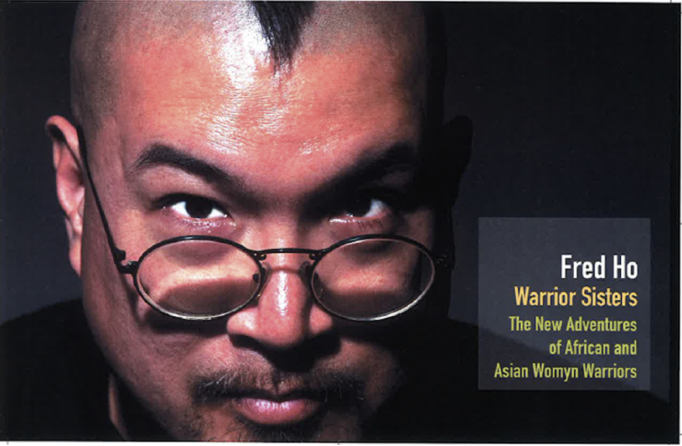
Electropore documents four Black and Asian womxn characters who engage with quantifiable and recorded tasks under conditions of surveillance and confined space and movement. The womxn exist connected yet isolated within a closed system. These conditions are evocative of the work model for mass production, and reflect Black and Asian womxn’s experiences and endured histories of oppression and violence to the body. Liu focuses on what she identifies as the shared realities of “BIPOC womxn’s bodies as the invisible machinery of global industrial capitalism.”
Like Ho, Liu is invested in the power of a coalition politic: both Electropore and Warrior Sisters explore the possibility of an Asian and Black communist coalitionary force. Ho and Greene’s opera models coalition-building by creating historical connections between oppressed diasporas and narratives around capitalism as a common enemy. Liu’s Electropore approaches the task by asking the viewer to imagine space for coalition and organizing within the common embodied experiences of Asian and Black womxn. Liu provokes questions about how systems of capitalist growth, mass production, and excessive waste marginalize and isolate the bodies of BIPOC womxn communities, further reducing the possibility for political organizing. As the artist notes, “these womxn share a life of narrow spans of movement, confined imaginaries, impossibly reduced windows of time, the body horror of a self compressed into bits of fixed knowledge, shareable trauma PDFs, tragedy spectacle service work, and emotional capital turned into current. Is there hope for a coalition politic there?”
WHEN SPEAKING ON PSCS as a body of work, Liu asserts that “nothing in Pink Slime Caesar Shift is just one thing.” The pink slime aspect of PSCS refers in part to in-vitro grown beef cells that are harvested in what look like vats of pink slime. When this commonly utilized ingredient of mass meat production was brought into public view in 2012, a series of dramas unfolded around the engineering process. These cells are mass produced artificial extruded meat additives, resulting from scientific efforts to make the production of meat as efficient and waste-free as possible. However, the media encouraged public hysterica over these additives through the circulation of inaccurate and triggering information and images. Liu wanted PSCS to examine and interact with manufactured versions of reality—a “whole affected quantity that was true even if everything creating that affective quantity was fake. The facts are fake. The implications of the images are fake. But with very real consequences culturally, politically, and economically.”
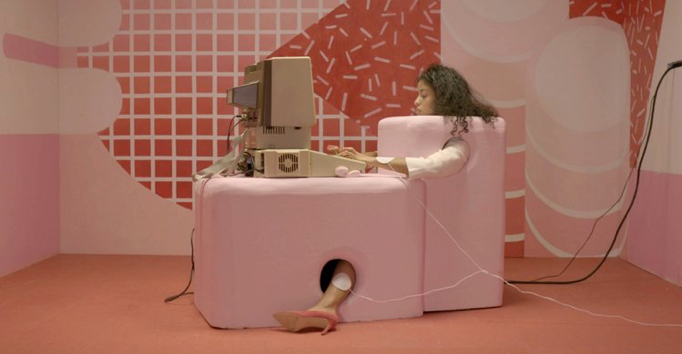
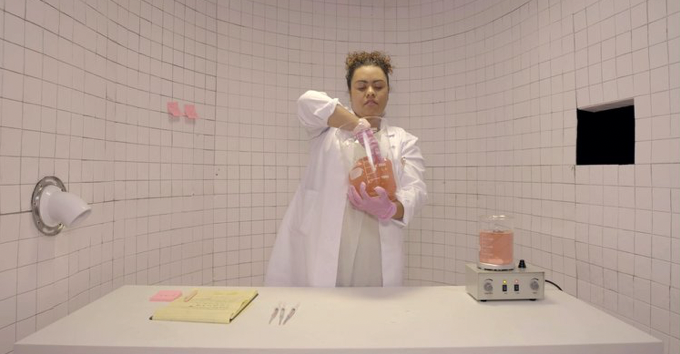
According to Liu, the PSCS series is built upon networks of feminist organizing, genetic engineering, and “genomic sequencing as a greater metaphor of a technologically altered future for the biological cell.” Working with biologist Sumeyye Yar, Liu investigated and utilized several techniques for genetically manipulating and encoding the DNA of in-vitro beef cells. Following these processes, the DNA of these cells can be decoded to reveal texts on labor rights and organizing. The beef cells host this information, similar to the way an external hard drive can be used to disseminate material and communicate via its contents. Building on this genetic experimentation, Liu dissects and reframes the various aspects of this research and practice to create videos in the PSCS series that comment on topics such as the biopolitics of globalization, the obscure legal frameworks of late-capitalist production, histories of secret feminist communications, and contemporary labor and feminist activism in China.
For her newest work in the series, Electropore, Liu positions electroporation as the central method of cellular manipulation. This technique lightly electrocutes cells, allowing pathways to open throughout their membranes. This procedure creates avenues for new content to enter the cell’s body, thus providing space for the insertion of synthetic DNA into the beef cells. The characters in Electropore simulate various steps in this process. The womxn work in a segregated chain of operation, manipulating pink balls or bubbles through a series of quantifiable tasks that evoke the work conditions of mass production. Liu’s video creates connections between scientific practices and existing socio-economic and political conditions that frame the realities of “the continuation of intergenerational poverty and the amplification of [economic] toxicity as a biological future.”
Electropore's conceptual connection to electricity as a tool begins at the cellular level. However, my research with Jen focused on forms of electrical networks and the cultivation of electricity via a variety of technological fantasies, realities, products, and gadgets. Electricity as a source of power has shaped and reshaped the world, resulting in devices and treatments that have global implications. Electropore’s characters highlight isolated acts that resemble electronic device production through metaphorical actions and energetic transactions that occur between them and the given technologies they interact with. Liu also inserts technologies such as electrostimulation therapy, LED-based skincare, and other electronic gadgets into the fabric of the piece.
Electropore, like Liu’s other work, endeavors to create instability for the viewer. Her pieces provoke the viewer to consider the emotional event of “landing on one foot in a place, and then all of a sudden having the ground ripped out from under you and being in a different place.” The womxn in Electropore subsist in a seemingly closed system of production. But what happens when that system glitches or is fractured? Throughout the piece, characters experience various disruptions within their personal work models, highlighting broken fractal space as the beginnings of communication, dissemination, and coalition.
LIU’S PRACTICE IS INHERENTLY POLITICAL, examining and critiquing the social and economic structures that define our world. The work engages with hidden yet urgent realities. However, Electropore is not somber: the video is a space of inquiry, visibility, and possibility. Liu creates a whimsical, campy, fem space to confront the viewer with radical truths while the womxn construct a slimy pink product bound in electrical current. Liu hopes to further the power that the people hold for enacting change by raising awareness about the oppressive forces and consequences of late-capitalist production. Her final statement of our interview echoes this principle, asking all consumers to consider “the bodies that are breaking because we're having a conversation right now that is utilizing some kind of technology. That is the center of the practice.” An overflowing container of research, Electropore—and Liu’s artistic practice overall—conceptually and aesthetically envision versions of our world that are confusing, intriguing, and necessary, providing the possibility for beauty out of ugly, sad, and desperate realities.
